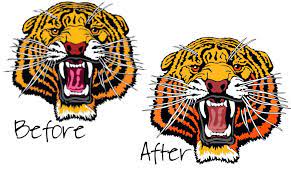It always works out for me about embroidery digitizing services– you study other people’s files and think that “I could do it …”, and when you sit down and start sculpting something like that yourself, it turns out that not everything is so smooth. This is how it works for me with the creation of lace designs (fsl) and cutwork, about which information from the Galkin’s nose. You have to collect all the information in a heap, comprehend and digest it, many techniques from what you read and see need to be tested for plausibility, and even more to master yourself.
But after all my ordeals, I nevertheless drew conclusions for myself, although, quite possibly, I will not tell anyone anything new, I will nevertheless voice:
1. Lace can be created in absolutely any software.
2. I called the principle of lace construction “the crocodile principle”. The meaning of all body movements when creating a program is that all frame lines (reinforcing), on which the design is held on the bones, should be intertwined. If this is not observed, the embroidery will fall apart in the hands. The rules for constructing these lines are something like this:
The side view shows that the bobbin thread and the top thread of line 3 “bite” the first two lines:
That is, you need to find the value of the overlap with which the transverse line will bite the longitudinal one.
3. Under all the braids, so that they are not loose, there must be at least 2 lines.
4. Under the satin stitch rollers, frames should be made, for plumpness, for example, edge run + doubles zigzag.
5. You can play around with satin densities, depending on what you want to get. Variations can be from 0.3 to 1-1.5 mm. Again, the density of the fillings must be oriented exclusively to the type of thread used.
6. Openwork grids should be made according to the principle of lattices, and not according to the principle of motive fillings.
7. Threads. After all my trials and experiments settled on thin # 60 polyester (I use Serafil 120/2 from Amann), and then only because getting thin cotton is a problem. And in the worst case, I use ordinary embroidery polyester # 40. The decision to switch to thin threads was prompted by the advertising catalogs of Criswell designs – they directly indicate is the best way to embroider. I put the bobbin thread not the same as on top, as everyone recommends, but the usual bobbin thread (thickness 150). The best version is the Isa 180 from Amann.
8. The stabilizer is only a water-soluble mesh, not a film. Preferably in 2 layers, if the project contains a lot of stitches. I came to the choice of this stabilizer on my own, although I tried to online embroidery digitizing on any stabilizers… Judging by the videos on YouTube, the absolute majority prefers to use water-soluble fabric.
9. Needles are standard. I embroider what is on my car. And there are almost all # 70-75, SES tip. If you don’t remember the difference between the types of needles. The needles, as some recommend, I do not change every 5-7 hours of embroidery, I only as a last resort – if suddenly the thread often breaks when using the same bobbin of thread. Otherwise, you will not save up any money for consumables. I do not use any specially coated needles.
It remains a mystery so far:
- How to make satin (satin) rollers, which are not embroidered on the base or along the edge of some kind of mesh, but simply hang on bridles, can maintain any shape, for example, this one, without disintegrating:
And so that to support this shape, I did not have to use a zigzag along the edge.
The most amazing thing is that all those principles of creating lace, which I came to empirically, have long been outlined in black and white in the oldest (1960) manual on free-running machine embroidery Granko, Shanty, and Shnei-Krasikova. You just need to transfer them to software and that’s it – there is happiness. Today I opened this book and wondered why I hadn’t read it thoughtfully and attentively before, and spent a lot of time on inventing the next bicycle.
PS I would like to at least take a peek at the latest generation of professional software narrowly sharpened for the creation of lace designs. For example, on ProLace 4.5 Advanced Embroidery Design & Punching Software or on EPC win. It takes a long time to create lace by hand. But you learn a lot while you build them.
